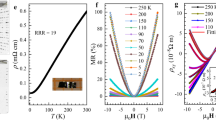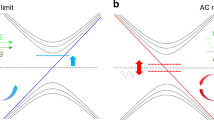Abstract
The chiral anomaly is the predicted breakdown of chiral symmetry in a Weyl semimetal with monopoles of opposite chirality when an electric field is applied parallel to a magnetic field. It occurs because of charge pumping between monopoles of opposite chirality. Experimental observation of this fundamental effect is plagued by concerns about the current pathways. Here we demonstrate the thermal chiral anomaly, energy pumping between monopoles, in topological insulator bismuth–antimony alloys driven into an ideal Weyl semimetal state by a Zeeman field, with the chemical potential pinned at the Weyl points and in the absence of any trivial Fermi surface pockets. The experimental signature is a large enhancement of the thermal conductivity in an applied magnetic field parallel to the thermal gradient. This work demonstrates both pumping of energy and charge between the two Weyl points of opposite chirality and that they are related by the Wiedemann–Franz law.
This is a preview of subscription content, access via your institution
Access options
Access Nature and 54 other Nature Portfolio journals
Get Nature+, our best-value online-access subscription
$29.99 / 30 days
cancel any time
Subscribe to this journal
Receive 12 print issues and online access
$259.00 per year
only $21.58 per issue
Buy this article
- Purchase on Springer Link
- Instant access to full article PDF
Prices may be subject to local taxes which are calculated during checkout




Similar content being viewed by others
Data availability
The data generated and analysed in this study are available within the paper and its Supplementary Information. Further data are available from the corresponding author on reasonable request.
References
Weyl, H. Elektron und gravitation. Z. Phys. 53, 330–352 (1929).
Nielsen, H. B. & Ninomiya, M. The Adler–Bell–Jackiw anomaly and Weyl fermions in a crystal. Phys. Lett. 130B, 389–396 (1983).
Christenson, J. H., Cronin, J. W., Fitch, V. L. & Turlay, R. Evidence for the 2π decay of the K20 meson. Phys. Rev. Lett. 13, 138–140 (1964).
Arnold, F. et al. Negative magnetoresistance without well-defined chirality in the Weyl semimetal TaP. Nat. Commun. 7, 116157 (2016).
Huang, X. et al. Observation of the chiral-anomaly-induced negative magnetoresistance in 3D Weyl semimetal TaAs. Phys. Rev. X 5, 031023 (2015).
Zhang, C.-L. et al. Signatures of the Adler–Bell–Jackiw chiral anomaly in a Weyl fermion semimetal. Nat. Commun. 7, 10735 (2016).
Spivak, N. Z. & Andreev, A. V. Magnetotransport phenomena related to the chiral anomaly in Weyl semimetals. Phys. Rev. B 93, 085107 (2016).
Liang, S. et al. Experimental tests of the chiral anomaly magnetoresistance in the Dirac–Weyl semimetals Na3Bi and GdPtBi. Phys. Rev. X 8, 031002 (2018).
Li, Q. et al. Chiral magnetic effect in ZrTe5. Nat. Phys. 12, 3648 (2016).
Li, H. et al. Negative magnetoresistance in Dirac semimetal Cd3As2. Nat. Commun. 7, 10301 (2016).
Guo, S. T. et al. Large transverse Hall-like signal in topological Dirac semimetal Cd3As2. Sci. Rep. 6, 27487 (2016).
Li, Y. et al. Field-induced resistivity plateau and unsaturated negative magnetoresistance in topological semimetal TaSb2. Phys. Rev. B 94, 121115(R) (2016).
Li, Y. P. et al. A negative magnetoresistance in topological semimetals of transition-metal dipnictides with nontrivial Z2 indices. Preprint at https://arxiv.org/abs/1603.04056 (2016).
Luo, Y. K. et al. Anomalous electronic structure and magnetoresistance in TaAs2. Sci. Rep. 6, 27294 (2016).
Shen, B., Deng, X. Y., Kotliar, G. & Ni, N. Fermi surface topology and negative longitudinal magnetoresistance observed in the semimetal NbAs2. Phys. Rev. B 93, 195119 (2016).
Baker, D. R. & Heremans, J. P. The linear geometrical magnetoresistance effect: influence of geometry and material composition. Phys. Rev. B 59, 13927 (1999).
Hu, J. S., Rosenbaum, T. F. & Betts, J. B. Current jets, disorder, and linear magnetoresistance in the silver chalcogenides. Phys. Rev. Lett. 95, 186603 (2005).
Li, Y. et al. Negative magnetoresistance in Weyl semimetals NbAs andNbP: intrinsic chiral anomaly and extrinsic effects. Front. Phys. 12, 127205 (2017).
dos Reis, R. D. et al. On the search for the chiral anomaly in Weyl semimetals: the negative longitudinal magnetoresistance. New J. Phys. 18, 085006 (2016).
Noothoven van Goor, J. M. Donors and Acceptors in Bismuth Philips Research Report Suppl. 4 (Philips, 1971).
Jin, H. et al. The phonon-induced diamagnetic force and its effect on the lattice thermal conductivity. Nat. Mater. 14, 601–606 (2015).
Das, K. & Agarwal, A. Thermal and gravitational chiral anomaly induced magneto-transport in Weyl semimetals. Phys. Rev. Res. 2, 013088 (2020).
Gallo, C. F., Chandrasekhar, B. S. & Sutter, P. H. Transport properties of bismuth single crystals. J. Appl. Phys. 34, 144–152 (1963).
Andreev, A. V. & Spivak, B. Z. Longitudinal negative magnetoresistance and magnetotransport phenomena on conventional and topological conductors. Phys. Rev. Lett. 120, 026601 (2018).
Schindler, C. et al. Anisotropic electrical and thermal magnetotransport in the magnetic semimetal GdPtBi. Phys. Rev. B 101, 125119 (2020).
Gooth, J. et al. Experimental signatures of the mixed axial–gravitational anomaly in the Weyl semimetal NbP. Nature 547, 324–327 (2017).
Tolman, R. C. & Ehrenfest, P. Temperature equilibrium in a static gravitational field. Phys. Rev. 36, 1791–1798 (1930).
Luttinger, J. M. Theory of thermal transport coefficients. Phys. Rev. 135, A1505–A1514 (1964).
Hsieh, D. et al. A topological Dirac insulator in a quantum spin Hall phase. Nature 452, 970–974 (2008).
Vandaele, K., Otsuka, M., Hasegawa, Y. & Heremans, J. P. Confinement effects, surface effects, and transport in Bi and Bi1−xSbx semiconducting and semimetallic nanowires. J. Phys. Condens. Matter 30, 403001 (2018).
Liu, Y. & Allen, R. E. Electronic structure of the semimetals Bi and Sb. Phys. Rev. B 52, 1566–1577 (1995).
Cucka, P. & Barrett, C. S. The crystal structure of Bi and of solid solutions of Pb, Sn, Sb and Te in Bi. Acta Crystallogr. 15, 865–872 (1962).
Mendez, E. E., Misu, A. & Dresselhaus, M. S. Pressure-dependent magnetoreflection studies of Bi and Bi1−xSbx alloys. Phys. Rev. B 24, 639–648 (1981).
Brandt, N. B., Svistova, E. A. & Semenov, M. V. Electron transitions in antimony-rich bismuth–antimony alloys in strong magnetic fields. Sov. Phys. JETP 32, 238 (1971).
Şahin, C. & Flatté, M. E. Tunable giant spin hall conductivities in a atrong spin-orbit semimetal: Bi1−xSbx. Phys. Rev. Lett. 114, 107201 (2015).
Cohen, M. H. & Blount, E. I. The g-factor and de Haas–van Alphen effect of electrons in bismuth. Philos. Mag. 5, 115–126 (1960).
Smith, G. E., Baraff, G. A. & Rowell, J. M. Effective g-factor of electrons and holes in bismuth. Phys. Rev. 135, A1118 (1964).
Vecchi, M. P., Pereira, J. R. & Dresselhaus, M. S. Anomalies in the magnetoreflection spectrum of bismuth in the low-quantum-number limit. Phys. Rev. B 14, 298–317 (1976).
Heremans, J. P., Shayegan, M., Dresselhaus, M. S. & Issi, J.-P. High magnetic field thermal conductivity measurements in graphite intercalation compounds. Phys. Rev. B 26, 3338–3346 (1982).
Kagan, V. D. & Red’ko, N. A. Phonon thermal conductivity of bismuth alloys. Sov. Phys. JETP 73, 664–671 (1991).
Argyres, P. N. & Adams, E. N. Longitudinal magnetoresistance in the quantum limit. Phys. Rev. 104, 900–908 (1956).
Acknowledgements
This work was supported by CEM and NSF MRSEC under grant numbers DMR-2011876 (to D.V., W.Z., N.T., J.P.H.) and DMR-1420451 (all authors). The authors acknowledge useful discussions with M. A. H. Vozmediano. R. Ripley edited the text and contributed to the illustrations.
Author information
Authors and Affiliations
Contributions
The experiments were designed and carried out by D.V. and J.P.H. The theory was carried out by W.Z., C.Ş., M.E.F., N.T. and J.P.H. All contributed to the integration of theory and experiment and in writing the manuscript.
Corresponding author
Ethics declarations
Competing interests
The authors declare no competing interests.
Additional information
Peer review information Nature Materials thanks Kamran Behnia, Qiang Li, Binghai Yan and the other, anonymous, reviewer(s) for their contribution to the peer review of this work.
Publisher’s note Springer Nature remains neutral with regard to jurisdictional claims in published maps and institutional affiliations.
Supplementary information
Supplementary Information
Supplementary figures and tables.
Rights and permissions
About this article
Cite this article
Vu, D., Zhang, W., Şahin, C. et al. Thermal chiral anomaly in the magnetic-field-induced ideal Weyl phase of Bi1−xSbx. Nat. Mater. 20, 1525–1531 (2021). https://doi.org/10.1038/s41563-021-00983-8
Received:
Accepted:
Published:
Issue Date:
DOI: https://doi.org/10.1038/s41563-021-00983-8
This article is cited by
-
Relaxation terms for anomalous hydrodynamic transport in Weyl semimetals from kinetic theory
Journal of High Energy Physics (2024)
-
Tunable electron–flexural phonon interaction in graphene heterostructures
Nature (2023)



